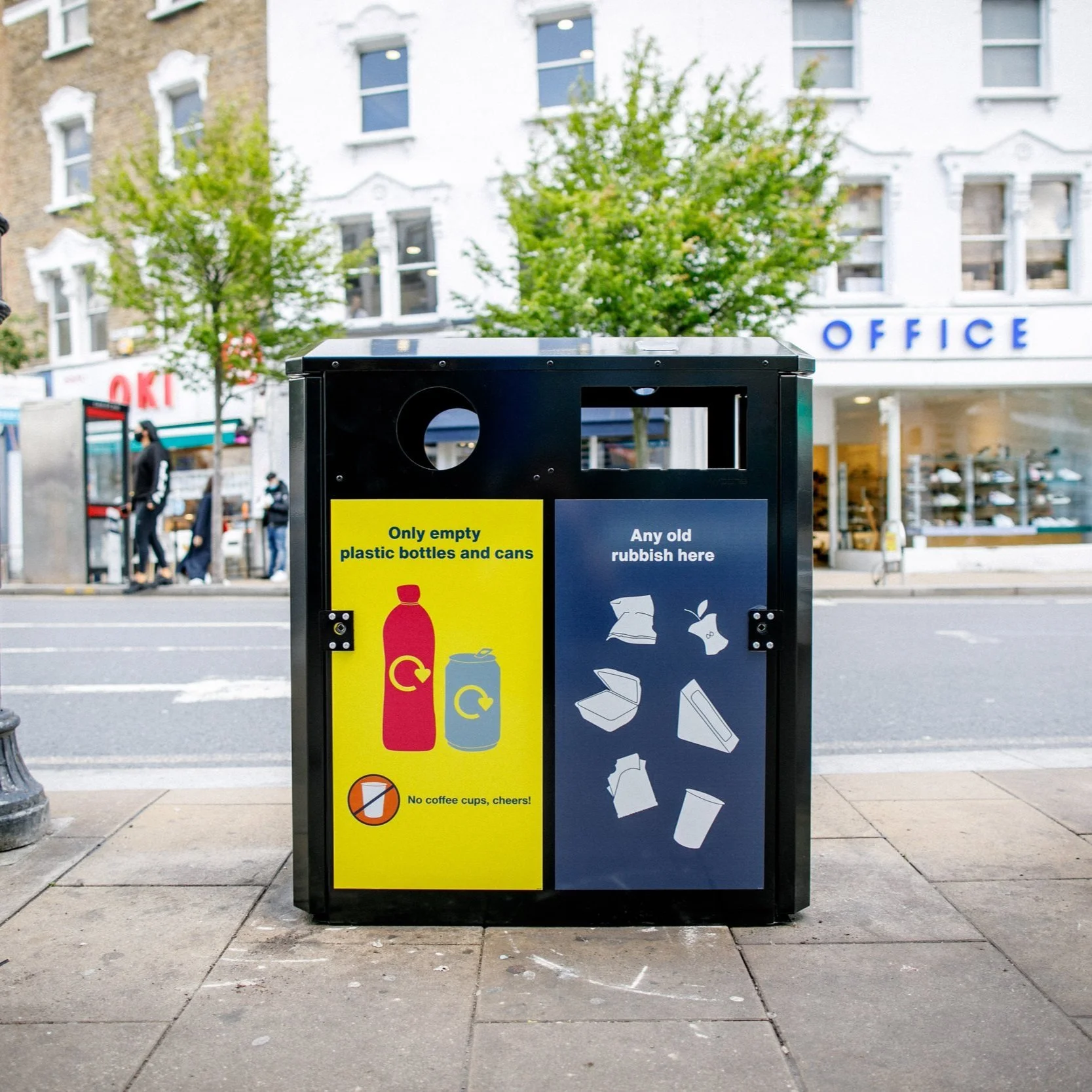Choosing the right bin
Across our seven campaigns, we’ve trialled a number of bin design modifications to make correct recycling the easiest and quickest thing to do.
These designs are based on the behaviour change principles of choice architecture, nudging people to make the right decision and increasing the visibility (or, salience) of the bins with bright colours and clear icons.
All of the design files are linked under ‘Resources’, so you can simply download them to use yourself, or share with a bin manufacturer or printer.
Bin design the #InTheLoop way








Bright Colours:
In order for people to notice the bins on streets, it helps for them to stand out. Surveys from throughout campaigns show that one of the key reasons for littering or not recycling was that there wasn’t a bin nearby (even though in many cases there was).
That’s why we went for the deliberate choice of bright yellow for #InTheLoop. It is one of the most noticeable colours and isn’t related to any of the WRAP guideline colours for different types of waste.
Clear simple instructions:
As discussed in ‘what to collect’, our designs focus on simple plain language and large icons in WRAP guideline colours to create consistency.
This has also included telling what people not to do – especially for items where the public are unsure whether or not it can be recycled, such as coffee cups. If possible, repeat instructions on the top and side of the bins too to help make sure people have seen what they need to recycle by the time they get to the bin.
Apertures:
We’ve been sorting shapes since we were babies, and to help people to put the right things (e.g. cylindrical containers) in the bin use a circular aperture and make sure your general waste aperture is large enough to fit everything else. In Edinburgh, we saw a 20% drop in contamination just from adding apertures onto the bins.
We’ve tried bins both with open apertures, as well as those with foot pedals and handles. People will often opt for the easiest bin to use, so we’d recommend not placing an open recycling bin next to a general waste bin that needs to interacted with to be opened. If you have a bin with handle, it’s important this is cleaned regularly and if there is a foot pedal that it is well labelled.
Bins need buddies:
Choice architecture is a fancy term to describe the design of different ways in which choices can be presented. We’ve found recycling bins should always be paired with a general waste bin or use a dual bin to reduce the contamination. Remember, people are going to be spend less than 2 seconds at a bin and are unlikely to walk a long distance from bins.
If you had to do just one thing?
Even if you don’t have a large budget, repositioning your bins, adding some new bright labels with clear instructions could be enough to tackle contamination issues on your bins. See ‘the resources’ to download a copy of the #InTheLoop designs.
Manufacturers:
If you want to work with a manufacturer who’s worked with #InTheLoop in the past, we’ve worked with (in alphabetical order): Broxap, Glasdon, Hartecast, Leafield, Unisan and Wybone.
#InTheLoop case study
Wimbledon #InTheLoop
Messaging:
The original bins design employed a nudge, that encouraged people to decide between landfill or recycling. However, we opted to update this messaging as the bigger issue for recycling is not about people’s motivation to recycle, but their motivation to recycle too much, known as ‘wishful recycling’ and the waste audit revealed high levels of packaging that was too contaminated to be recycled.
Design and signage:
Despite that the fact that over 95% people surveyed had said they had seen a recycling bin before, 50% said they had not recycled because there had not been a bin nearby at the time.
Our baseline audit revealed that only 5 in 10 of the plastic bottles and cans were ending up in recycling suggesting the current messaging was not as clear as it could be. The bright designs, simple messaging and circular apertures and saw an instant boost in in the collection of target materials. At the mid-campaign and final campaign waste composition we saw that now 9 in 10 plastic bottles and cans were ending up in the recycling alongside a reduction in contamination.

